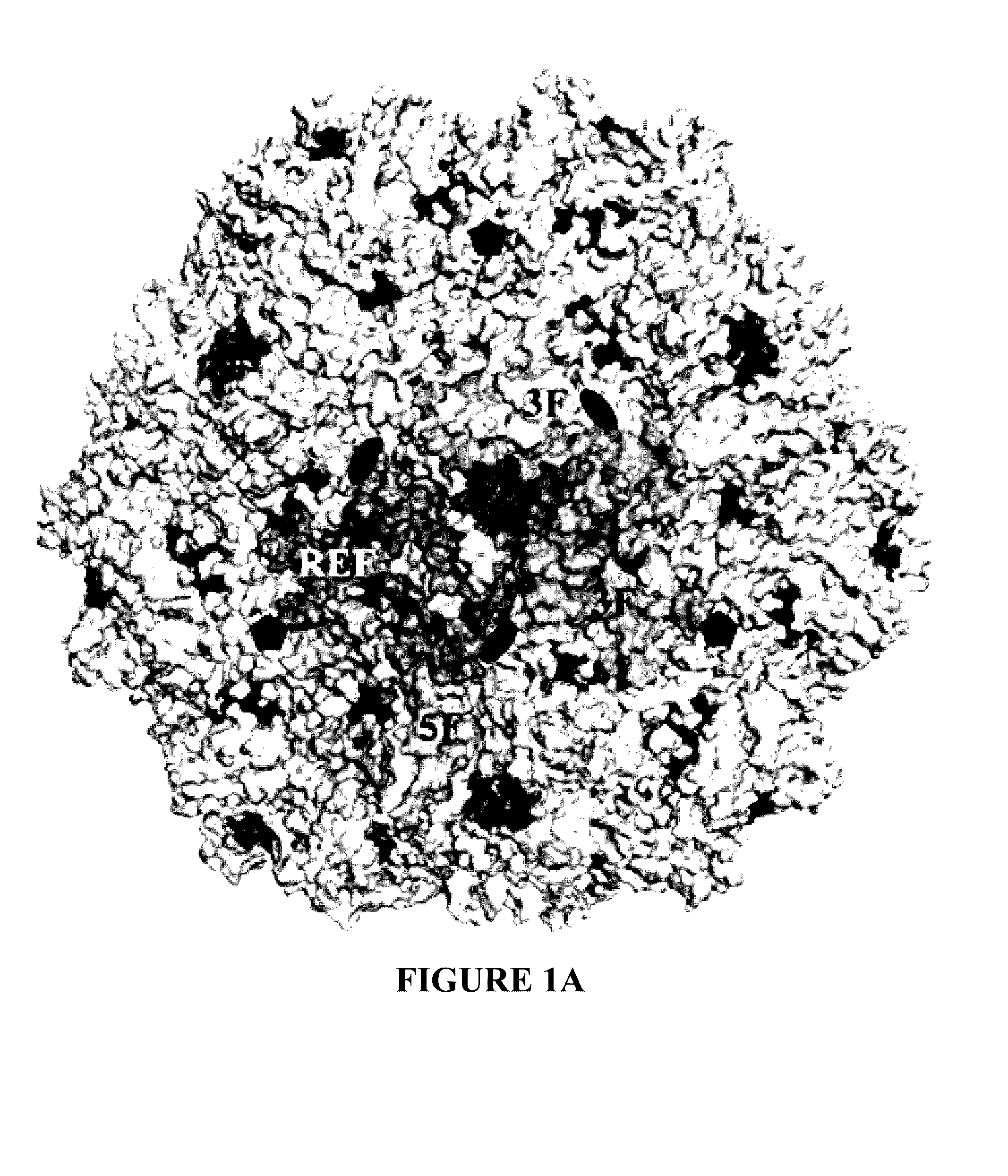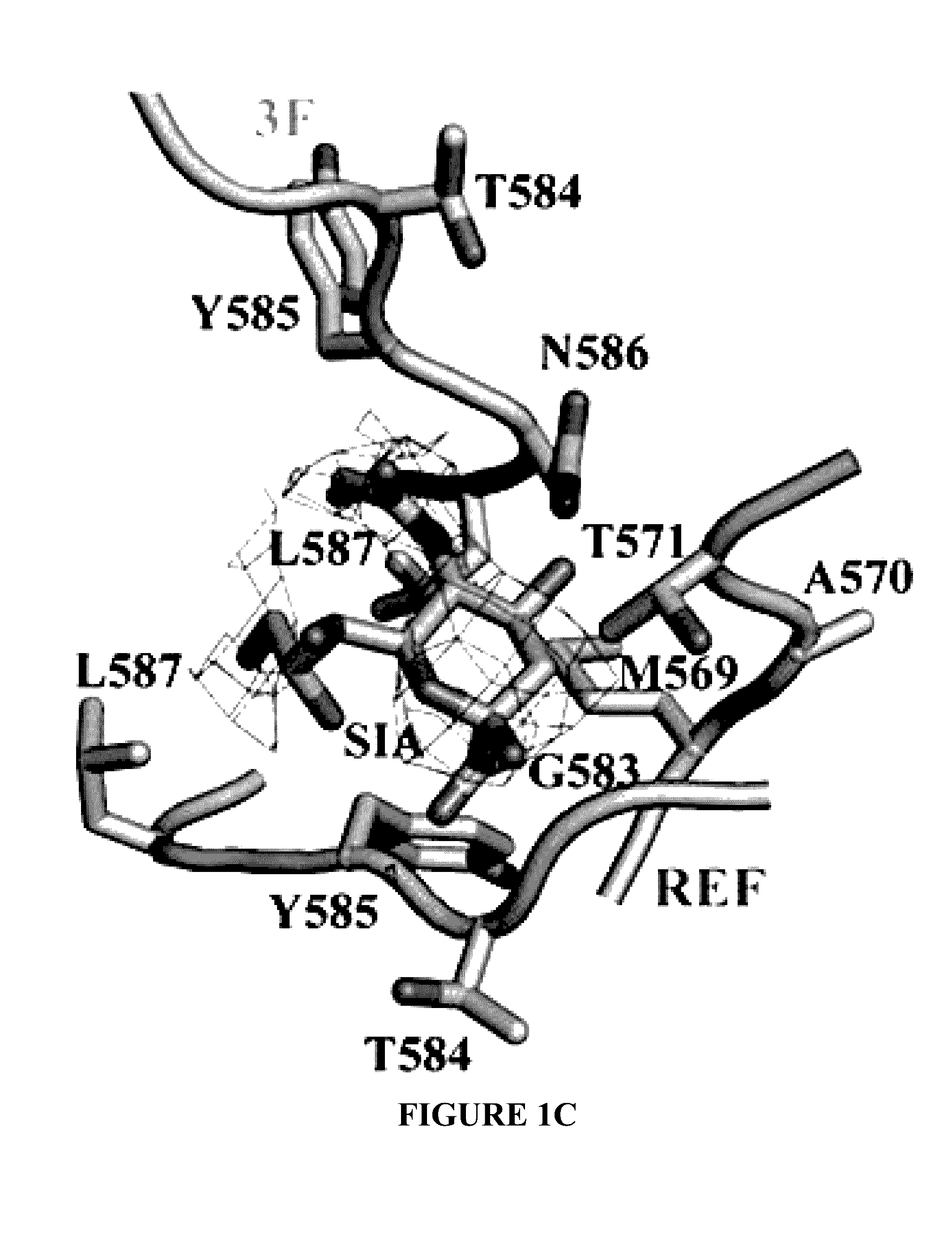Adeno-Associated Vectors for Enhanced Transduction and Reduced Immunogenicity
a technology of adenovirus and a vector, applied in the field of adenovirus, can solve the problems of affecting and blocking the attachment of a virus to a cell, and many current aav vectors remain inefficient at delivering heterologous nucleic acid molecules to their intended target cells
- Summary
- Abstract
- Description
- Claims
- Application Information
AI Technical Summary
Benefits of technology
Problems solved by technology
Method used
Image
Examples
example 1
Mutagenesis of the Sialic Acid Binding Regions of AAV5 Results in Elimination or Alteration in Sialic Acid-Dependent Transduction
[0085]As a genus, the dependoviruses use a diverse group of cell surface carbohydrates for attachment and entry. Despite the fact that a majority of adeno-associated viruses (AAVs) utilize sialic acid (SIA) for binding and transduction, this virus-carbohydrate interaction is poorly understood. Utilizing X-ray crystallography, two SIA binding regions were mapped for AAV5. The first site mapped to the depression in the center of the 3-fold axis of symmetry, while the second site was located under the βHI loop close to the 5-fold axis. Mutagenesis of amino acids 569 and 585 or 587 within the 3-fold depression resulted in elimination or alteration in SIA-dependent transduction, respectively. This change in SIA binding was confirmed using glycan microarrays. Mutagenesis of the second site identified a role in transduction that was SIA independent. Further studi...
example 2
Delivery and Expression of Nucleic Acid of Interest in Subretinal Tissue of the Eye Vector Production
[0108]Mutant capsid plasmids of this invention, including capsids having the A-site mutants M569V, Y585V, and L587T mutants, and the double mutant Y585V / L587T, and the B-site mutants D652F, T362M, Q359D, E350Q, P533S, P533G, are prepared as described in Example 1. Wild-type AAV5 and recombinant virus comprising the capsid mutant vectors expressing luciferase are produced as described in Example 1.
Injections: The in vivo study of transgene expression is conducted as described in Example 1. Vector particles (3×1012 vg / ml viral particles) of WT AAV5 or recombinant vectors encoding luciferase are injected into mice by subretinal injection.
Subretinal Injection Technique
[0109]To study retinal cell transduction in rats, Adult Wistar rats (375-425 g) are anesthetized with intraperitoneal ketamine (50 mg / kg) and xylazine (5 mg / kg) and topical 1% proparacaine eye drops and pupils are dilated w...
example 3
Delivery and Expression of Nucleic Acid of Interest in Intravitreal Space in the Eye Vector Production
[0113]Mutant capsid plasmids of this invention, including capsids having the A-site mutants M569V, Y585V, and L587T mutants, and the double mutant Y585V / L587T, and the B-site mutants D652F, T362M, Q359D, E350Q, P533S, P533G, are prepared as described in Example 1. Recombinant virus comprising the capsid mutant vectors expressing a transgene are produced as described in Example 1.
Injections
[0114]The in vivo study of transgene expression is conducted as described in Example 1. Vector particles (3×1012 vg / ml viral particles) of recombinant vectors encoding luciferase are injected into mice by intravitreal injection.
Intravitreal Injection Technique
[0115]To study retinal cell transduction in rats, Adult Wistar rats (375-425 g) are anesthetized with intraperitoneal ketamine (50 mg / kg) and xylazine (5 mg / kg) and topical 1% proparacaine eye drops and pupils are dilated with 1% tropicamide a...
PUM
| Property | Measurement | Unit |
|---|---|---|
| Fraction | aaaaa | aaaaa |
| Fraction | aaaaa | aaaaa |
| Fraction | aaaaa | aaaaa |
Abstract
Description
Claims
Application Information
 Login to View More
Login to View More - R&D
- Intellectual Property
- Life Sciences
- Materials
- Tech Scout
- Unparalleled Data Quality
- Higher Quality Content
- 60% Fewer Hallucinations
Browse by: Latest US Patents, China's latest patents, Technical Efficacy Thesaurus, Application Domain, Technology Topic, Popular Technical Reports.
© 2025 PatSnap. All rights reserved.Legal|Privacy policy|Modern Slavery Act Transparency Statement|Sitemap|About US| Contact US: help@patsnap.com



